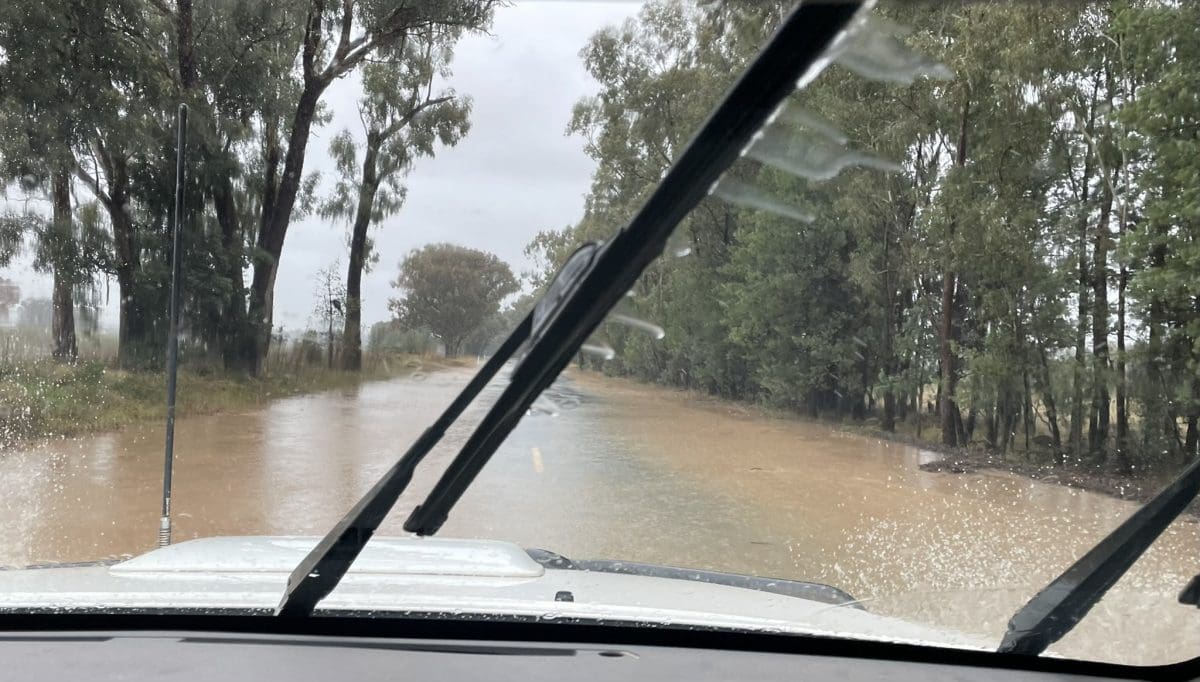
Heavy rain in parts of NSW and Queensland including this section of the Mary Gilmore Way east of Barmedman, NSW, has slowed traffic and reduced farm access. Photo: Kim Storey
A SHORTAGE of grain in the Port Adelaide zone is lifting prices for wheat and barley stored up-country in the southern half of New South Wales and throughout Victoria, and pushing domestic values to premiums well above export bids.
The Adelaide-driven rally is a function of competition from traders filling mostly bulk export orders, and consumers who have had to lift bids to more than $20/t above the comparable port price to keep their mills fed.
Rain now falling across many parts of the Australian grainbelt is mostly ideal for winter crops now being planted, but has been excessive and could cause damage to emerging seedlings.
Rain over much of NSW and Queensland is hampering the movement of grain in many parts of eastern Australia by preventing outturn from up-country storages.
| Today | May 5 | |
| Barley Downs | $435 | $405 |
| SFW wheat Downs | $460 | $435 |
| Sorghum Downs | $360 | $360 |
| Barley Melbourne | $428 | $422 |
| ASW wheat Melbourne | $455 | $430 |
| SFW wheat Melbourne | $445 | $420 |
Table 1: Indicative delivered prices in Australian dollars per tonne.
Rain blights northern logistics
In Queensland and northern NSW, rain has stopped the picking of cotton and harvest of late sorghum in most areas.
In the week to 9am today, most of Central Queensland has had soaking rain, ideal for just-planted wheat and barley.
Registrations include: Capella 97mm; Clermont 86mm; Emerald 88mm, and Springsure 82mm.
Rain has been patchier in southern Queensland, where falls include: Dalby 82mm; Jondaryan 51mm; Roma 27mm; Surat 65mm.
Road closures are now in effect in some parts of Queensland due to another round of localised flooding.
In NSW, rain has dodged some areas, and soaked others; registrations include: Mungindi 42mm; Narrabri 19mm; Peak Hill 18mm; Temora 40mm; Walgett 64mm, and West Wyalong 45mm.
Stewarts Grains trader Robert Quinn said this latest rain means more logistics challenges for growers, traders and transport operators in northern NSW.
“There’s plenty of grain around, it’s just very hard to execute,” Mr Quinn said.
“Everyone’s playing catch-up, and the markets are all firmer.”
Plenty of consumers across the eastern half of Australia are throwing out big bids in order to fill short positions made more acute by a lack of transport, and compounded by recent days of wet weather.
“It feels like everyone’s letting everyone down at the moment; if you’ve got trucks, you can’t load, and if you can load, you can’t get trucks.”
“The rain means more logistics challenges for everyone.”
In NSW, Robinson Grain wheat trader Jock Benham said the weakening Australian dollar was helping to lift values, and delivered port markets were rising at around $10-$15/t per week.
“It’s not getting any cheaper, and it’s hard to try and execute much at the moment because of the wet weather and transport issues.”
South tightens
Across Victoria, southern NSW and South Australia, growers are mostly past the halfway mark in their winter-sowing programs.
Traders said they have little interest in selling grain, and even less in carting it.
It has made the already-tight road-freight situation even tighter, and has consumers bidding up big to pull grain into their sites.
Horizon Grain Brokers managing director Ash Munro said prices for wheat in the Port Adelaide track market had risen sharply in the past week on export demand, and domestic consumers had no choice but to follow the rally.
“Buyers are reaching into north-west Victoria, and buying out of sites that would normally feed into Portland and Geelong.”
Trade sources say domestic feedmills in the Port Adelaide zone are bidding around $25-$45/t above equivalent Melbourne prices for SFW to compete with export, and feedlots were bidding as high as $400/t on farm for feed barley.
“The SA market is really driving it.”
Mr Munro said high prices on offer at harvest saw a greater-than-normal proportion of grain warehoused, and a reduced proportion of cereals held on farm which would normally flow in dribs and drabs to the domestic market.
“The domestic market has been suffering for some time; feedlots are finding it hard to find grain on farm.”
Mr Munro said the low-yielding crops harvested in parts of SA last year have reduced the region’s ability to supply domestic as well as export demand in the Port Adelaide zone.
“Some places in the SA Mallee and elsewhere didn’t have a great year last year, and some had a really bad year.
“I don’t see demand softening, and unsold tonnes just aren’t there.”
Recieve Grain Central’s free news letter straight to your inbox – Click here
